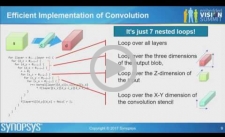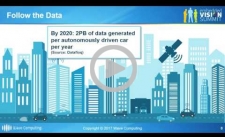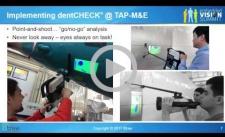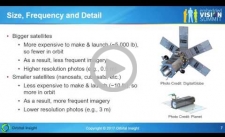|
Moving CNNs from Academic Theory to Embedded Reality
In this presentation from Tom Michiels, System Architect for Embedded Vision Processors at Synopsys, you will learn to recognize and avoid the pitfalls of moving from an academic CNN/deep learning graph to a commercial embedded vision design. You will also learn about the cost vs. accuracy trade-offs of CNN bit width, about balancing internal memory size and external memory bandwidth, and about the importance of keeping data local to the CNN processor to improve bandwidth. Michiels also walks through an example customer design for a power- and cost-sensitive automotive scene segmentation application that requires high flexibility to adapt to future CNN graph evolutions.
Enabling the Full Potential of Machine Learning
With the growing recognition that “data is the new oil,” more companies are looking to machine learning to gain competitive advantages and create new business models. But the machine learning industry is still in its infancy, and constraints such as data center-based training and the lack of near-real time training results limit our ability to realize the potential machine learning offers. In this presentation, Derek Meyer, CEO of Wave Computing, offers insights into the evolution of the machine learning industry and outlines opportunities for growth for companies across many industries once key obstacles are removed.
|
|
Designing Vision Systems for Human Operators and Workflows
During the past several decades, manual measurement methods – using rulers and dial gauges – have been the status quo for inspecting dents, bumps, lightning strikes and corrosion blend-out on an aircraft. These traditional methods have been time-consuming and prone to subjectivity and human error. Emerging optical inspection technologies are changing things for the better. User-centric, vision-based tools empower operators to achieve greater efficiency, accuracy and consistency, slashing inspection and reporting times by 90%, without requiring extensive training or workflow changes. This presentation from Arun Chhabra, CEO of 8tree, discusses how such emerging tools, designed to address real-world problems, can improve aircraft turn-around-time, while enhancing safety through an improved understanding of airframe reliability.
Using Satellites to Extract Insights on the Ground
Satellites are great for seeing the world at scale, but analyzing petabytes of images can be extremely time-consuming for humans alone. This is why machine vision is a perfect complement for satellite imagery: providing human-quality analysis at inhuman scale. This talk from Boris Babenko, Senior Software Engineer at Orbital Insight, explains how different types of satellites are best suited to different types of observation and discusses applications of machine vision. Babenko looks at how this technology was able to not only detect previously unknown oil tanks in China, but also estimate how much oil the country stores in these tanks. He also looks at how simple metrics like car density and building density can be applied to both commercial and humanitarian applications. The talk concludes by examining the possibilities for the future as our ability to both take and process images continues to grow.
|







